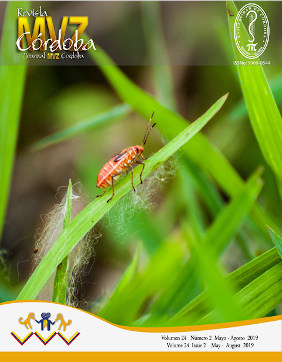Selection markers in Pampa Rocha pigs: a comparison with autochthonous breeds of Spain and Portugal
Marcadores de selección en cerdos Pampa Rocha: comparación con razas autóctonas de España y Portugal
Show authors biography
Objective. The analysis of selection markers allows to obtain information about the evolutive story of a particular breed or line and allows also to evaluate the usefulness of those markers for breeding programs. We have analyzed SNPs in four genes of the creole pig breed Pampa Rocha and we have compared their allelic frequencies with the allelic frequencies of diverse autochthonous breeds of Spain and Portugal and also with Piétrain pigs and wild boars. Materials and methods. The SNPs were analyzed using diverse RT-PCR methods. Results. The results of the analysis show that Pampa Rocha pigs have similar allelic frequencies with the autochthonous breeds of Spain and Portugal especially in the case of IGF2 and also, but not so coincident, in the case of PEPCK-C. However, they differ considerably for MC4R, and also, but in a lower extent, for PRKAG3. We discuss in this work the usefulness of our results for breeding of Pampa Rocha pigs. Conclusions. Our results demonstrate the peculiarity of the Pampa Rocha breed regarding the markers studied.
Article visits 1374 | PDF visits
Downloads
1. Latorre P, Burgos C, Hidalgo J, Varona L, Carrodeguas JA, López-Buesa, P. c.A2456C-substitution in Pck1 changes the enzyme kinetic and functional properties modifying fat distribution in pigs. Sci Rep. 2016; 6:19617. https://doi.org/10.1038/srep19617
2. Font-i-Furnols M, Tous N, Esteve-Garcia E, Gispert M. Do all the consumers accept the marbling in the same way? The relation between visual and sensory acceptability of pork. Meat Sci. 2012; 91(4):448-453. https://doi.org/10.1016/j.meatsci.2012.02.030
3. Reina R, López-Buesa P, Sánchez del Pulgar J, Ventanas J, García C. Effect of IGF-II (insulin-like growth factor-II) genotype on the quality of dry-cured hams and shoulders. Meat Sci. 2012; 92(4):562-568. https://doi.org/10.1016/j.meatsci.2012.05.027
4. Pugliese C, Sirtori F. Quality of meat and meat products produced from southern European pig breeds. Meat Sci. 2012; 90(3):511-518. https://doi.org/10.1016/j.meatsci.2011.09.019
5. Van Laere AS, Nguyen M, Braunschweig M, Nezer C, Collete C, Moreau L et al. A regulatory mutation in IGF2 causes a major QTL effect on muscle growth in the pig. Nature. 2003; 425(6960):832-836. https://doi.org/10.1038/nature02064
6. Kim KS, Larsen N, Short T, Plastow G, Rothschild MF. A missense variant of the melanocortin-4-receptor (MC4R) gene is associated with fatness, growth, and feed intake traits. Mam Genome. 2000; 11(2):131–135. https://doi.org/10.1007/s003350010025
7. Ciobanu D, Bastiaansen J, Massoud M, Helm J, Woollard J, Plastow G, Rothschild M. Evidence for new alleles in the protein kinase adenosine monophosphate-activated g3-subunit gene associated with low glycogen content in pig skeletal muscle and improved meat quality. Genetics. 2001; 159(3):1151–1162. PMID: 11729159
8. Montenegro M, Llambí S, Castro G, Barlocco N, Vadell A, Landi V et al. Genetic characterization of Uruguayan Pampa Rocha pigs with microsatellite markers. Genet Mol Biol. 2015; 38(1):48-54. https://doi.org/10.1590/s1415-475738120140146
9. Fuentes V, Ventanas S, Ventanas J, Estévez M. The genetic background affects composition, oxidative stability and quality traits of Iberian dry-cured hams: Purebred Iberian versus reciprocal Iberian × Duroc crossbred pigs. Meat Sci. 2014; 96(2):737-743. https://doi.org/10.1016/j.meatsci.2013.10.010
10. Burgos C, Galve A, Moreno C, Altarriba J, Reina R, García C, López-Buesa. The effects of two alleles of IGF2 on fat content in pig carcasses and pork. Meat Sci. 2012; 90(2):309-313. https://doi.org/10.1016/j.meatsci.2011.07.016
11. Burgos C, Carrodeguas JA, Moreno C, Altarriba J, Tarrafeta L, Barcelona JA et al. Allelic incidence in several pig breeds of a missense variant of pig melanocortin-4 receptor (MC4R) gene associated with carcass and productive traits; its relation to IGF2 genotype. Meat Sci. 2006; 73(1):144-150. https://doi.org/10.1016/j.meatsci.2005.11.007
12. Galve A, Burgos C, Varona L, Carrodeguas JA, López-Buesa P. Allelic frequencies of PRKAG3 in several pig breeds and its technological consequences on a Duroc 9 Landrace-Large White cross. J Anim Breed Genet. 2013; 130(5):382-393. https://doi.org/10.1111/jbg.12042
13. Saintilan R, Mérour I, Schwob S, Sellier P, Bidanel J, Gilbert H. Genetic parameters and halothane genotype effect for residual feed intake in Piétrain growing pigs. Livest Sci. 2011; 142(1-3):203-209. https://doi.org/10.1016/j.livsci.2011.07.013
14. Van den Maagdenberg K, Stinckens A, Claeys E, Buys N, De Smet S. Effect of the insulin-like growth factor-II and RYR1 genotype in pigs on carcass and meat quality traits. Meat Sci. 2008; 80(2):293-303. https://doi.org/10.1016/j.meatsci.2007.12.008
15. Li C, Bin Y, Curchoe C, Yang L, Feng D, Jiang Q et al. Genetic imprinting of H19 and IGF2 in domestic pigs (Sus scrofa). Anim Biotechnol. 2008; 19(1):22–27. https://doi.org/10.1080/10495390701758563
16. Stinckens A, Mathur P, Janssens S, Bruggeman V, Onagbesan OM, Schroyen M et al. Indirect effect of IGF2 intron3 g.3072G>A mutation on prolificacy in sows. Anim Genet. 2010; 41(5):493-498. https://doi.org/10.1111/j.1365-2052.2010.02040.x
17. Krashes MJ, Lowell BB, Garfield AS. Melanocortin-4 receptor-regulated energy homeostasis. Nat Neurosci. 2016; 19(2):206-219. https://doi.org/10.1038/nn.4202
18. Shen WJ, Yao T, Kong X, Williams KW, Liu T. Melanocortin neurons: Multiple routes to regulation of metabolism. Biochim Biophys Acta. 2017; 1863(10 Pt A):2477-2485. https://doi.org/10.1016/j.bbadis.2017.05.007
19. Davoli R, Braglia S, Valastro V, Annaratone C, Comella M, Zambonelli et al. Analysis of MC4R polymorphism in Italian Large White and Italian Duroc pigs: association with carcass traits. Meat Sci. 2012; 90(4):887-892. https://doi.org/10.1016/j.meatsci.2011.11.025
20. Switonski M, Mankowska M, Salamon S. Family of melanocortin receptor (MCR) genes in mammals-mutations, polymorphisms and phenotypic effects. J Appl Genet. 2013; 54(4):461-472. https://doi.org/10.1007/s13353-013-0163-z
21. Škrlep M, Kavar T, Santé-Lhoutellier V, Čandek-Potokar M. Effect of I199V polymorphism at PRKAG3 gene on carcass and meat quality traits in Slovenian commercial pigs. J Muscle Foods. 2009; 20(3):367-376. https://doi.org/10.1111/j.1745-4573.2009.00158.x
22. Salas RC, Mingala C. Genetic Factors Affecting Pork Quality: Halothane and Rendement Napole Genes. Anim Biotechnol. 2017; 28(2):148-155. https://doi.org/10.1080/10495398.2016.1243550
























